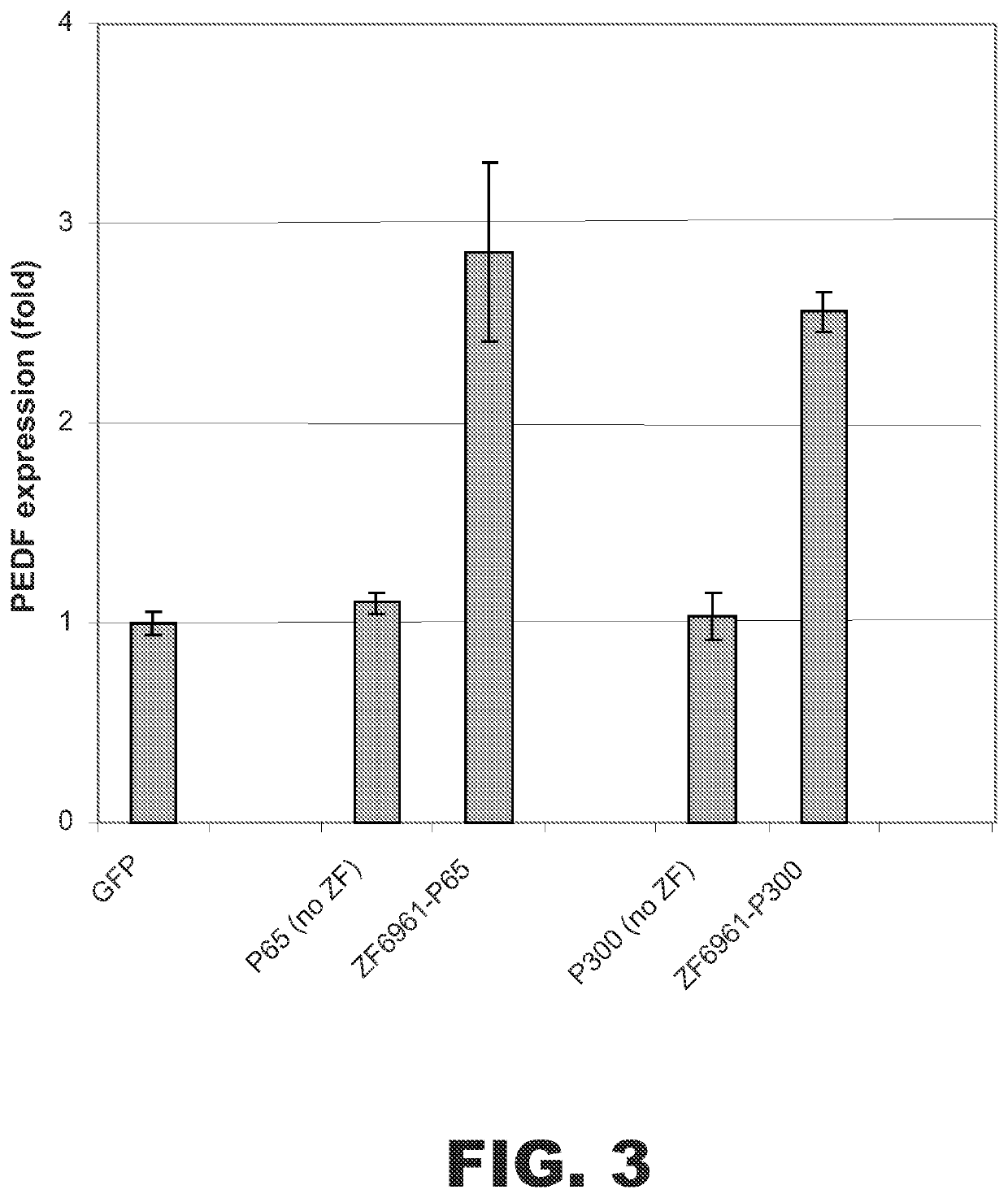Targeted histone acetylation
a technology of histone acetylation and target acetylation, which is applied in the direction of peptides, transferases, peptide sources, etc., can solve the problems of global and non-specific methods of histone acetylation, and no way of modifying histone acetylation at specific locations
- Summary
- Abstract
- Description
- Claims
- Application Information
AI Technical Summary
Benefits of technology
Problems solved by technology
Method used
Image
Examples
example 1
p300 Fusion Protein Acetylated Histones Associated with Oct4 Gene
A fusion protein was designed to target a specific sequence near the transcriptional start site of the human OCT4 gene. The fusion protein contained a zinc finger (ZF) DNA binding domain and a HAT domain derived from human E1A binding protein p300 (i.e., p300 HAT domain). The ZF binding domain was designed to bind the specific sequence 5′-GGAGGGcCAGGAATCGGGC-3′ (SEQ ID NO:1) starting at nucleotide +181 downstream from the transcriptional start site of OCT4. This ZF DNA binding domain, termed ZF(Oct4+181), had the following amino acid sequence:
AAMAERPFQCRICMRNFSDRSHLTRHIRTHTGEKPFACDICGRKFARNDDRKKHTKIH TGSQKPFQCRICMRNFSQSGNLARHIRTHTGEKPFACDICGRKFAAKWNLDAHTKIHT HPRAPIPKPFQCRICMRNFSRSAHLSRHIRTHTGEKPFACDICGRKFAQSGHLSRHTKI HLRQKDAAR (SEQ ID NO:2). The HAT domain corresponded to amino acids 1284-1673 of human E1A binding protein p300 (accession number: NM_001429). Amino acids 1284-1673 are in bold in the sequence of human E1A...
example 2
81)-p300 Fusion Protein Increased Oct4 Expression
Additional ZF-p300 HAT domain fusion proteins were designed that targeted sequences located at nucleotides −720 or −615 upstream of the transcriptional start site of OCT4: ZF(Oct4-720)-p300 and ZF(Oct4-615)-p300. A second set of control fusion proteins containing NF-κB subunit p65 was also constructed to use as positive controls: ZF(Oct4+181)-p65 and ZF(Oct4-720)-p65.
Expression vectors encoding ZF(Oct4+181)-p300 or one of the control fusion proteins described above were transfected into HEK 293 cells. Control cells were transfected with vectors encoding GFP, p65 (no ZF), or p300 (no ZF). After 48 hrs, the cells were harvested and total RNA was isolated. The levels of OCT4 mRNA and cyclophilin A (i.e., PPIA) endogenous control mRNA were measured by real time reverse transcriptase polymerase chain reaction (RT-PCR) (Life Technologies, Carlsbad, Calif.). The OCT4 / cyc ratio was used for normalizing OCT4 expression. As shown in FIG. 2, the...
example 3
p300 Fusion Protein Increased PEDF Expression
To test whether ZF fusion proteins comprising the p300 HAT domain were able to activate other genes, a ZF DNA binding domain fusion was designed to target the human PEDF (pigment epithelium-derived factor) gene. The ZF binding domain was designed to bind the specific sequence 5′-GGATGGtGGTGCAGCAGTG-3′ (SEQ ID NO:7) starting at nucleotide −92 upstream from the transcriptional start site of the sequence encoding PEDF. The ZF(PEDF) DNA binding domain was termed ZF6961 and had the following amino acid sequence:
AAMAERPFQCRICMRNFSRSDALSRHIRTHTGEKPFACDICGRKFAQSGDLTRHTKIH TGGQRPFQCRICMRNFSQSGDLTRHIRTHTGEKPFACDICGRKFATSGHLSRHTKIHT GGGGSQKPFQCRICMRNFSRSDHLSNHIRTHTGEKPFACDICGKKFAQSATRITHTKIH LRQKDAAR (SEQ ID NO:8). The ZF(PEDF) DNA binding domain was linked to either the p300 HAT domain or the NF-κB p65 subunit.
Expression vectors encoding ZF(PEDF)-p300 or ZF(PEDF)-p65 were transfected into HEK 293 cells. Control cells were transfected with vectors e...
PUM
| Property | Measurement | Unit |
|---|---|---|
| nucleic acid | aaaaa | aaaaa |
| affinity | aaaaa | aaaaa |
| length | aaaaa | aaaaa |
Abstract
Description
Claims
Application Information
 Login to View More
Login to View More - R&D
- Intellectual Property
- Life Sciences
- Materials
- Tech Scout
- Unparalleled Data Quality
- Higher Quality Content
- 60% Fewer Hallucinations
Browse by: Latest US Patents, China's latest patents, Technical Efficacy Thesaurus, Application Domain, Technology Topic, Popular Technical Reports.
© 2025 PatSnap. All rights reserved.Legal|Privacy policy|Modern Slavery Act Transparency Statement|Sitemap|About US| Contact US: help@patsnap.com



